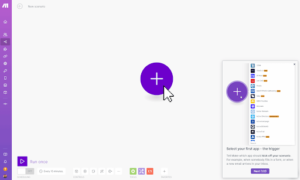Introduction:
The fourth concept, closely related to the use of digital, is automation, where process automation leads to better organization of work. Make.com is a strong automation tool that assists users in tasks and linking several applications together efficiently. Regardless of whether you belong to the category of beginners or the one who wants to have more in-depth information, this Make.com guide for beginners and Make.com beginner’s guide is going to help people who have no experience with it at all. Because it runs through setup all the way to advanced-level functions, this guide is the quintessential Make.com tutorial for beginners on instruments. So, stay with Siznam for a complete Make.com guide for beginners.
What is make.com?
Make.com is a tool that helps users automate tasks by connecting different apps and services. It’s like setting up a system where certain actions happen automatically when something triggers them. For example, when you receive an email, Make.com can automatically save the attachment to a cloud storage service.
This platform supports many different apps, making it easy to handle repetitive tasks, save time, and boost productivity. It’s great for both individuals and businesses who want to make tasks like data entry, communication, and project management easier by linking various tools and automating workflows.
Getting Started with Make.com:
If this is the first time you are using Make.com, here are the steps to follow to start using it. Getting started with Make.com can seem daunting. However, with the help of this Make.com basics guide, you can realize that the creation and functioning of the site is quite easy and comprehensible. This Make.com introduction for beginners will walk you through the essential steps and provide a simple Make.com setup guide to help you get started smoothly.
Make.com Setup Guide
However, a rationale requires you to set up your Make first before proceeding to work on your creation of workflows account. Here’s a Make.com setup guide to help you get started.

Sign Up: Going to the Make site. thanks go to the creation of an account on the com website. There is a trial version which you can use for a specified length of time to be able to enjoy all the features.
Dashboard Overview : After signing in, there is the Make.com dashboard where all your extensions and their Rules and features are all combined in something they call “scenarios”, where you can handle all your workflows.
Connecting Apps: Make.com supports a variety of applications including. These are apps which can be linked to other apps in order to form automation scenarios between the apps.
Make. com Walkthrough for Beginners:
Since you have established your account, it is time for a Make.com walkthrough for beginners. Here let us explain to you the tools and steps of the given platform to make you understand it in a better way.
1.Creating a Scenario: Scenarios are what you build on Make and each of them is a set of steps that you design for yourself. They include a set of events and operations that assure the execution of a given action. For instance, you can make a sort of integration whereby you are notified of new emails in Gmail and this automatically creates a task in Trello.
2.Triggers and Actions: In Make.com, triggers are initiate scenarios based on specific conditions or events. They are essential components in creating workflows that automate tasks across various applications. In a scenario, a trigger is an event that starts the set of actions whereas actions are tasks executed as a result of the trigger.
3.Modules: Scenarios consist of modules. They are enabling elements that comprise triggers, actions, which govern the working logic of your macro.
Make. com Tutorial for Beginners
Thus, for those who like to spend time working on the situation, this Make.com tutorial for beginners provides a step-by-step guide for beginners on creating your first scenario.

Here’s a simple Make.com setup guide to create your first scenario:
- Choose a Trigger: Start by selecting an app and the specific event that will trigger the scenario. For example, “New row added in Google Sheets.”
- Set Up Actions: Next, choose the action that should follow. You can add multiple actions, such as “Send a notification in Slack” and “Update another Google Sheet.”
- Test Your Scenario: Before activating it, test your scenario to ensure it works as expected. Make.com allows you to simulate scenarios to catch any issues early.
- Activate and Monitor: Once tested, activate your scenario. You can monitor its performance and make adjustments as needed.
Additional Tips for Beginners
- Start Simple: Begin with simple scenarios and gradually move on to more complex ones as you become more comfortable with the platform.
- Use Templates: Make.com offers pre-made templates for common scenarios. These can be a great starting point and can be customized to suit your needs.
- Explore the Community: The Make.com community is a valuable resource. You can find tutorials, ask questions, and share your own scenarios.
Conclusion:
Make.com is ideal for users who want to automate their work processes without needing advanced programming skills. With its user-friendly design, extensive app support, and flexibility in fitting various scenarios, it’s easy to get started. Whether you’re a small business owner, a freelancer, or just looking for simpler, more efficient ways to manage daily tasks, this Make.com guide for beginners has all the information you need.
So, dive into this Make.com beginner’s guide from Siznam and get familiar with automation. By following the Make.com tutorial for beginners, you’ll learn how to create efficient workflows that save time and streamline tasks. This Make.com guide for beginners by Siznam will help you set up the right automated actions to suit your needs, turning routine activities into a breeze. Enjoy the simplicity and efficiency of Make.com as it transforms your everyday tasks with Siznam’s expert guidance!






